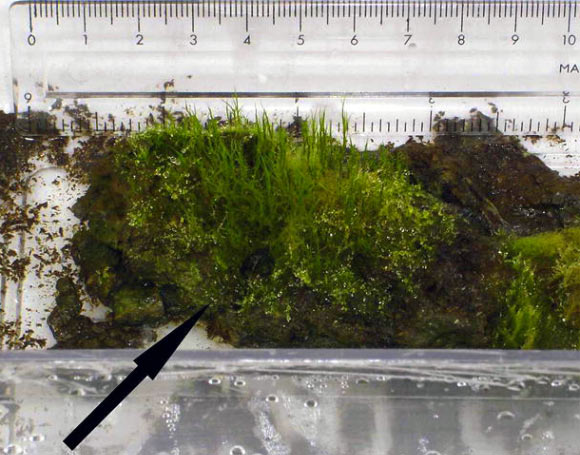British researchers have brought back to life 1,530-year-old moss recovered from Antarctic permafrost.

Extensive regrowth of the 1,530-year-old moss Chorisodontium aciplyllum. Image credit: Esme Roads et al.
Mosses are known to survive environmental extremes in the short-term with previous evidence confirming up to a 20 year timescale for survival. Their potential to survive much longer timescales had not previously been examined.
Mosses are an important part of the biology of both polar regions. They are the dominant plants over large areas and are a major storer of fixed carbon, especially in the north.
“What mosses do in the ecosystem is far more important than we would generally realize when we look at a moss on a wall here for instance. Understanding what controls their growth and distribution, particularly in a fast-changing part of the world such as the Antarctic Peninsula region, is therefore of much wider significance,” said Prof Peter Convey from the British Antarctic Survey, who is the senior author of the paper published in the journal Current Biology.
The moss core used in this study was obtained from Signy Island in maritime Antarctic. The island is well characterized both biologically and climatologically and is a known location of moss bank accumulation.
Mean summer air temperature on Signy Island is currently about plus 1 degree Celsius, decreasing to around minus 9 degrees Celsius in winter.
Prof Convey and his colleagues sliced the moss core very carefully, keeping them free from contamination, and placed them in an incubator at a normal growth temperature and light level. After only a few weeks, the moss began to grow.
Using carbon dating, the team identified the moss, known as Chorisodontium aciplyllum, to be at least 1,530 years of age, and possibly even older, at the depth where the new growth was seen.
Regeneration also occurred in the liverwort Cephaloziella embedded in organic material at the base of the core.
“This experiment shows that multi-cellular organisms, plants in this case, can survive over far longer timescales than previously thought. These mosses, a key part of the ecosystem, could survive century to millennial periods of ice advance, such as the Little Ice Age in Europe,” Prof Convey said.
“If they can survive in this way, then recolonization following an ice age, once the ice retreats, would be a lot easier than migrating trans-oceanic distances from warmer regions. It also maintains diversity in an area that would otherwise be wiped clean of life by the ice advance.”
“Although it would be a big jump from the current finding, this does raise the possibility of complex life forms surviving even longer periods once encased in permafrost or ice.”
“This work provides further evidence of the low decomposition rate generally attributed to mosses, and strengthens my conviction that the growth of mosses should be encouraged globally to act as a carbon sink and thus reduce global warming,” said co-author Dr Royce Longton from the University of Reading.
______
Esme Roads et al. 2014. Millennial timescale regeneration in a moss from Antarctica. Current Biology, vol. 24, no. 6, R222-R223; doi: 10.1016/j.cub.2014.01.053







